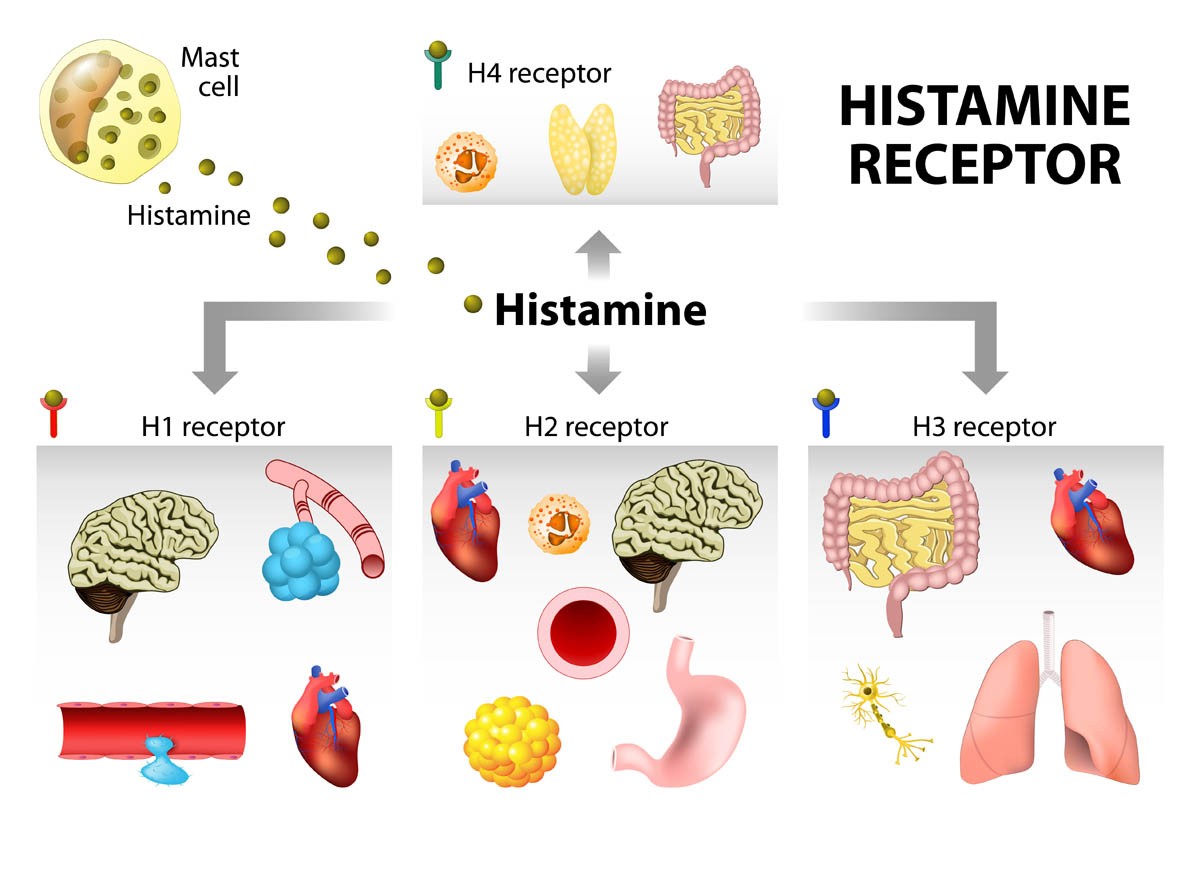|
What is Zyrtec?
Zyrtec (cetirizine) is a second-generation antihistamine that can treat allergy-related symptoms in cats. Antihistamines work by blocking the effects of histamine on certain cells within the body. When a cat has an allergic response, mast cells and basophils release histamine which binds to cells containing H1 receptors. Four types of receptors have been identified so far.
- H1 – Located in the smooth muscles, lining of blood vessels and airways.
- H2 – Found in the stomach cells and stimulates the secretion of stomach acid.
- H3 – Located in the neurons of the brain, influences neurotransmission.
- H4 – Found in the bone marrow and white blood cells, responsible for immune response.

The effects of histamine on the H1 receptors include the following:
- Vasodilation: Expansion (widening) of the blood cells causes more blood to flow to the area and increases permeability, which makes them leaky. This allows white blood cells and blood plasma proteins to move out of the blood vessel and migrate to the affected site. This leaking of fluid leads to localised swelling.
- Drop in blood pressure: Due to vasodilation.
- Bronchoconstriction: Narrowing of the airways in the lungs caused by smooth muscle contracting.
Types of antihistamines
Antihistamines are either first-generation or second generation. First-generation is older and generally cheaper to purchase; however, it can cross the blood-brain barrier leading to sedative effect. They also have a shorter half-life, meaning more frequent dosages are necessary. Zyrtec is a second-generation antihistamine.
First-generation antihistamines include:
- Chlorpheniramine (Iramine)
- Diphenhydramine (Benadryl)
- Promethazine (Phenergan)
- Hydroxyzine (Atarax)
- Periactin (Cyproheptadine)
Second-generation antihistamines are newer, but often more expensive. Benefits of second-generation include less drowsiness due to a lower blood-brain barrier penetration as well as a longer half-life. This means once a day administration is usually all that is required. Second-generation antihistamines may include:
- Cetirizine (Zyrtec)
- Loratadine (Claratyne)
- Levocetirizine
Throughout the article, I refer to this medication as Zyrtec, because that is what most pet owners call the product. Zyrtec is, in fact, the patented name for, cetirizine, but as it is now off-patent, there are many generic products available with the same ingredient as Zyrtec.
When purchasing Zyrtec (or its generic equivalent), let your pharmacist know it is for a cat, and make sure that cetirizine is the only active ingredient.
Symptoms of allergies in cats
The symptoms of allergies in cats tend to manifest as skin disorders; symptoms may come and go depending on the underlying cause. Common symptoms of allergies in cats include:
- Urticaria (rash)
- Miliary dermatitis (small, dry, crusty papules)
- Itching
- Overgrooming
- Hair loss
Uses
Pruritis: Itching associated with insect bite reaction, atopic dermatitis and hives
Eosinophilic granuloma complex: Zyrtec can help in the treatment of eosinophilic granuloma complex, which is an inflammatory skin condition characterised by lesions that affect multiple areas of the body including the face, lips, in particular, the abdomen and thighs
Contraindications
Always consult your veterinarian before administering any medications to a cat. Do not use Zyrtec in cats with the following:
- Cats with kidney disease
- Cats with liver disease
- Cetirizine or hydroxyzine sensitivity
- Pregnant cats
- Lactating cats
Dosage
Tablets are available 10mg tablets or chews. Dosage is 1/2 mg per pound or 1 mg per kilo.
Side effects
Side effects are lower for second-generation antihistamines, but may include:
- Vomiting
- Hypersalivation (drooling)
- Sedation
Antihistamine trials
Several other antihistamines are available to treat allergies and cats will respond differently to each one. Your veterinarian may recommend an antihistamine trial to find the most effective antihistamine for your cat.
The cat will receive one type of antihistamine for ten days to see if symptoms improve. If there is no improvement, the cat will move on to a different antihistamine for ten days; this will continue until the most effective antihistamine is found.
Treatment of acute flares
Initially, your cat may be put on steroids and antihistamines to relieve symptoms while the allergy is brought under control. In some cases, a secondary infection may have developed due to trauma to the skin. Antibiotics will be necessary to treat bacterial skin infections.
Once symptoms have improved, the steroids will be withdrawn, and he will remain on the antihistamines as long as is necessary.
How to reduce allergies in cats
Find and eliminate the cause of allergies is always the number one goal.
- If it is pollen, keep your windows closed during spring.
- Buy a vacuum cleaner with a HEPA filter; this can help to reduce allergens in the home.
- Carpeted flooring tends to hold onto allergens more readily than wooden floorboards.
- Give your cat weekly baths with a suitable antipruritic shampoo to remove allergens from the coat.
- Be diligent with flea control as flea allergy dermatitis is a prevalent cause of allergies in cats, it is important to treat the home as well as the cats.
- Omega-3 fatty acids can be of help to reduce inflammation.
- Immunotherapy for cats with atopic dermatitis. This works by administering a minute amount of the allergen to de-sensitise your cat. Allergy shots are tailored to use with each cat.

